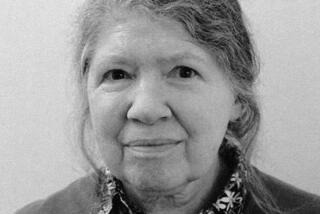Prairie blindness? Blame meningitis.
- Share via
More than a century after she went blind, a new study casts doubt on how bright, blue-eyed “Little House on the Prairie” older sister Mary Ingalls lost her vision.
Using medical papers from the 19th century, unpublished family journals and old newspaper clippings, medical historians claim it was viral meningoencephalitis that destroyed Ingalls’ vision in 1879, not the scarlet fever that wreaked havoc on families across the American frontier. They make their case for the new diagnosis in a study published in Monday’s edition of the journal Pediatrics.
Mary Ingalls was Laura Ingalls Wilder’s older sister. Both girls became famous through Wilder’s semiautobiographical book series about growing up on the American frontier in the 1800s. The books were inspired by Wilder’s unpublished memoir, “Pioneer Girl,” and they spawned a TV series starring Melissa Gilbert as Laura and Michael Landon as her father, Charles, better known as “Pa.”
In the show and the book series, Ingalls becomes blind as a teenager after suffering from scarlet fever, which was fatal in 15% to 30% of cases, the researchers wrote. Between 1840 and 1883, scarlet fever was one of the top four causes of blindness. The others were measles, meningitis and other misunderstood ailments of the day.
According to the study, the only mention of Mary Ingalls suffering from scarlet fever is in Wilders’ memoir, in which she writes that her sister was suffering from the sickness in 1872. But Ingalls’ sight doesn’t begin to disintegrate until 1879, when, Wilder writes, her sister had an “awful fever” and one side of her face was “drawn out of shape,” as if the nerves were paralyzed.
Doctors noted at the time that the nerves in Ingalls’ eyes were “dying,” never to recover.
Though the explanations for Ingalls various symptoms ranged from a stroke to measles to herpes simplex, viral meningitis seems the most likely, researchers contend.
There’s no proof Ingalls was suffering from scarlet fever when she finally went blind, and viral meningitis would cause a fever, nerve damage to the face and blindness, the authors wrote. While other diseases would bring other long-term complications like extended paralysis or loss of cognitive function, only meningitis lines up with the all of observations at the time, the new study concluded.
In a 1937 letter to her daughter, Wilder wrote that her sister Mary had suffered from a “spinal sickness,” which meningitis most certainly is.
Conclusions up till now, the authors write, were probably based on “tales of disease … woven into our culture, reinforced by recollections of a 19th century scourge on children.”
You can gain access to the report in Pediatrics online here.
Return to the Booster Shots blog.







